It looks like you're using an Ad Blocker.
Please white-list or disable AboveTopSecret.com in your ad-blocking tool.
Thank you.
Some features of ATS will be disabled while you continue to use an ad-blocker.
share:
originally posted by: DAVID64
a reply to: smurfy
do a Jeremy Clarkson on..
????
Good thread. I believe there was, at least, primitive life on Mars
Yes, Clarkson of Top Gear..he's well known for the use of a hammer when dealing with anything mechanical. That's just about exactly how Hoover described the actions of those in NASA or their co-opts who were responsible for totally erasing the Crinoid seen in the OP's picture.
Jeep puts up another very good thread concerning the possibility that life emerged on Mars in the past. All of this - the accumulating evidence from
other sciences, the slowly-mounting possible-fossil discovery in meteorites from Mars data, and some of the potential fossil-indicating lifeforms
found in places like the ATS anomalies thread (which is also a Jeep thread) amount to little-by-little indicators which should give scientists and
laypersons alike that the work has been, and will continue to be, valuable and possibly historic in nature and in result.
a reply to: Aleister
I second that! A lot of data and imagry has been acquired over the years and step by step Curiosity will add even more insights regarding the bigger picture.
I'd be really surprised if, in the end, the outcome of the MSL mission would be: nope, Mars wasn't hospitable enough (in the long run) to host complex life ... instead, I think the results will increasingly support a marine life scenario in the martian past!
I second that! A lot of data and imagry has been acquired over the years and step by step Curiosity will add even more insights regarding the bigger picture.
I'd be really surprised if, in the end, the outcome of the MSL mission would be: nope, Mars wasn't hospitable enough (in the long run) to host complex life ... instead, I think the results will increasingly support a marine life scenario in the martian past!
edit on 14-12-2014 by jeep3r because: text
Had water on Mars.
I do think one of the latest photos shows signs of some fluid on the surface. This is from Mars Mars gallery, Slide 9.
This is on the edge of a crater that had water. First picture shows broken "soil" half way up the picture and the colour of the broken soil i.e. below the surface being darker. I remember a similar effect when you dig sand near the edge of the sea, the sand below the surface is darker as it contains water.
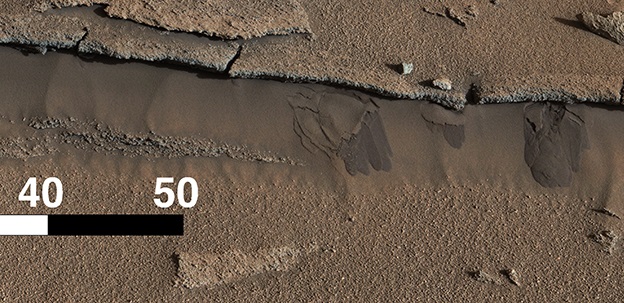
Now picture 2 from the same main picture is as interesting. There is a small funnel running through the middle with very few small stones appearing in the funnel that look as though they have been "washed away" by some fluid down the funnel.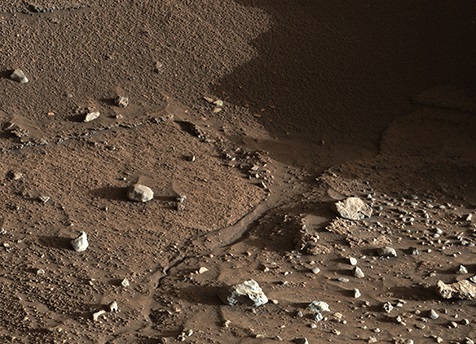 .
.
Apologies Op if this is taking away from your point, I think there is still water on mars and hence still some sort of life
I do think one of the latest photos shows signs of some fluid on the surface. This is from Mars Mars gallery, Slide 9.
This is on the edge of a crater that had water. First picture shows broken "soil" half way up the picture and the colour of the broken soil i.e. below the surface being darker. I remember a similar effect when you dig sand near the edge of the sea, the sand below the surface is darker as it contains water.

Now picture 2 from the same main picture is as interesting. There is a small funnel running through the middle with very few small stones appearing in the funnel that look as though they have been "washed away" by some fluid down the funnel.

Apologies Op if this is taking away from your point, I think there is still water on mars and hence still some sort of life
Howdy,
You've collected quite an assortment of interesting pictures, that's for sure. I do wish that you had included a sense of scale with the images, though. Working from crudely constructed size bars (and doing the digging... hehe. Geology, digging) isn't fun. : / I don't blame you personally for that, but I'd rather NASA gave some sense of scale...
Here's an image of the same rock with scale...
en.wikipedia.org...:LastChance_D_JG03-B058R1_br.jpg
Notice that the spherules in question are smaller than 0.4 cm, about 4 mm (much smaller than your sources...). Also notice the interpreted structure of cross-bedding. (requiring water movement). The "echinoderm" (crinoid/cystoid) stems would also be quite small compared to Earth crinoids, too. More remarkably, they columnals have managed to remain articulated in flowing water environments. (Not impossible, but there are certainly a lot there...) Now, you might notice the black lines on the above image being noted as lamination. Those lines fit pretty well with those "crinoidal" features, and in fact, are used to interpret the structure of the rock as sedimentary.
Now, as for the spherules being fossils... It's unlikely due to apparent concentration and distribution. Note the last paragraph in the wikipedia page...
en.wikipedia.org...
Fossils don't tend to "grow in place."
And this paper...
www.lpi.usra.edu...
Note the twinning in the spherules, suggesting mineral growth, not fossil. More importantly... the chemical/mineralogical signature of these layered spherules is hematite (iron oxide...). Though for fairness's sake, evidence might suggest that these are not concretionary growths, but rather impact growths...
www.lpi.usra.edu...
as for the "holdfasts," they look consistent with broken spherules, though the scaling seems a bit larger. Perhaps that's just sediment(ary rock) that was encasing the spherules, where the spherules have broken free due to differential weathering?
mars.jpl.nasa.gov...
To be more clear, the "fossils" are too small to be comparable to Earth species, and the images you're seeing look more like structural elements than actual fossils. Yet, I remain hopeful for fossils of life to be found on Mars, so don't take my opinion as discouraging. I do, however, think that life on Mars would not necessarily need to be analogous to Earth life... As a geology student, I'm afraid all I see is structural elements and mineral growth. (Admittedly, interpretations from pictures alone is very difficult, and I have to take other scientists' words on the mineralogy...).
Keep digging.
Sincere regards,
Hydeman
You've collected quite an assortment of interesting pictures, that's for sure. I do wish that you had included a sense of scale with the images, though. Working from crudely constructed size bars (and doing the digging... hehe. Geology, digging) isn't fun. : / I don't blame you personally for that, but I'd rather NASA gave some sense of scale...
Here's an image of the same rock with scale...
en.wikipedia.org...:LastChance_D_JG03-B058R1_br.jpg
Notice that the spherules in question are smaller than 0.4 cm, about 4 mm (much smaller than your sources...). Also notice the interpreted structure of cross-bedding. (requiring water movement). The "echinoderm" (crinoid/cystoid) stems would also be quite small compared to Earth crinoids, too. More remarkably, they columnals have managed to remain articulated in flowing water environments. (Not impossible, but there are certainly a lot there...) Now, you might notice the black lines on the above image being noted as lamination. Those lines fit pretty well with those "crinoidal" features, and in fact, are used to interpret the structure of the rock as sedimentary.
Now, as for the spherules being fossils... It's unlikely due to apparent concentration and distribution. Note the last paragraph in the wikipedia page...
en.wikipedia.org...
Fossils don't tend to "grow in place."
And this paper...
www.lpi.usra.edu...
Note the twinning in the spherules, suggesting mineral growth, not fossil. More importantly... the chemical/mineralogical signature of these layered spherules is hematite (iron oxide...). Though for fairness's sake, evidence might suggest that these are not concretionary growths, but rather impact growths...
www.lpi.usra.edu...
as for the "holdfasts," they look consistent with broken spherules, though the scaling seems a bit larger. Perhaps that's just sediment(ary rock) that was encasing the spherules, where the spherules have broken free due to differential weathering?
mars.jpl.nasa.gov...
To be more clear, the "fossils" are too small to be comparable to Earth species, and the images you're seeing look more like structural elements than actual fossils. Yet, I remain hopeful for fossils of life to be found on Mars, so don't take my opinion as discouraging. I do, however, think that life on Mars would not necessarily need to be analogous to Earth life... As a geology student, I'm afraid all I see is structural elements and mineral growth. (Admittedly, interpretations from pictures alone is very difficult, and I have to take other scientists' words on the mineralogy...).
Keep digging.
Sincere regards,
Hydeman
a reply to: templar knight
I'm not knowledgeable enough to say for sure, but I remember similar looking trails not too long ago on the anomalies thread which were analyzed and pretty well proven to be dust leaks. Someone may come along who can explain it better (and, of course, I may be wrong, just that your finds reminded me of those other posts).
I'm not knowledgeable enough to say for sure, but I remember similar looking trails not too long ago on the anomalies thread which were analyzed and pretty well proven to be dust leaks. Someone may come along who can explain it better (and, of course, I may be wrong, just that your finds reminded me of those other posts).
originally posted by: hydeman11
Notice that the spherules in question are smaller than 0.4 cm, about 4 mm (much smaller than your sources...). Also notice the interpreted structure of cross-bedding. (requiring water movement). The "echinoderm" (crinoid/cystoid) stems would also be quite small compared to Earth crinoids, too.
I appreciate the details you provided concerning the scale and mineralogical make-up of the features in question. Although: hermatite coated fossils are not unheard of, depending on the layers they're found in. As for the scale: yes, the cystoids and segments of the crinoid arms would certainly be a lot smaller than their terrestial counter-parts.
By the way: there were no spherules found in the vicinity of the holdfasts at Gale (AFAIK, except for that one you've linked to). Of course there could be a geological explanation for how all of these features were formed. But I find it astonishing that we see 3 different elements that are rather distinctive and very similar to a known marine ecosystem of our terrestial past.
In the end, I guess it comes down to the fact that we really need to substantiate any interpretations such as those posted in the OP. I do hope (and am fairly certain) that Curiosity will provide more data to do exactly that.
Again: thanks for your thouroughly drafted reply (incl. all the details and related research) and for your overall take on the situation ... !
edit on 14-12-2014 by jeep3r because: text
a reply to: jeep3r
Howdy,
Absolutely, hematite coated fossils (or even fossils completely replaced by iron oxides in general ) are more than possible. I'm lucky enough to live in an area with trilobite fossils with iron infiltrated exoskeletons, or even fossils replaced by pyrite and weathered to limonite (hydrous iron oxides). That doesn't explain away the twinning of the spherules. What does explain twinning in hematite rich environments is mineral growth. Botryoidal growth is common enough in hematite.
en.wikipedia.org...
Spherical geological features can also be explained by bolide impacts, as I alluded to earlier, of course. There are tektites (probably), spherulites, and lapilli, for example. Impacts create ejecta features.
en.wikipedia.org...
en.wikipedia.org...
en.wikipedia.org...
If that "holdfast" image was taken from a crater, such features might represent differential weathering of some kind of ejecta material? At any rate, it seems a lot like differential weathering to me, whether from ejecta or not.
en.wikipedia.org...
That said, I would be very surprised if there were truly no spherules in the area simple because of it's closeness to an impact site. : / That's quite interesting in and of itself. (Admittedly, meteor impact sites aren't my area of knowledge... More used to seeing sed. rocks than anything.)
Indeed, I agree that more evidence will be forthcoming from Curiousity, and these mysteries will have some light shed upon them. There is nothing more I'd like to see in my lifetime than evidence of extraterrestrial life. Features of layered rocks, evaporites, hematite concretions, and structural features indicating liquid deposition all point to possible life, so I wouldn't at all be surprised if fossils were found on Mars.
Cheers and kindest regards,
Hydeman
Howdy,
Absolutely, hematite coated fossils (or even fossils completely replaced by iron oxides in general ) are more than possible. I'm lucky enough to live in an area with trilobite fossils with iron infiltrated exoskeletons, or even fossils replaced by pyrite and weathered to limonite (hydrous iron oxides). That doesn't explain away the twinning of the spherules. What does explain twinning in hematite rich environments is mineral growth. Botryoidal growth is common enough in hematite.
en.wikipedia.org...
Spherical geological features can also be explained by bolide impacts, as I alluded to earlier, of course. There are tektites (probably), spherulites, and lapilli, for example. Impacts create ejecta features.
en.wikipedia.org...
en.wikipedia.org...
en.wikipedia.org...
If that "holdfast" image was taken from a crater, such features might represent differential weathering of some kind of ejecta material? At any rate, it seems a lot like differential weathering to me, whether from ejecta or not.
en.wikipedia.org...
That said, I would be very surprised if there were truly no spherules in the area simple because of it's closeness to an impact site. : / That's quite interesting in and of itself. (Admittedly, meteor impact sites aren't my area of knowledge... More used to seeing sed. rocks than anything.)
Indeed, I agree that more evidence will be forthcoming from Curiousity, and these mysteries will have some light shed upon them. There is nothing more I'd like to see in my lifetime than evidence of extraterrestrial life. Features of layered rocks, evaporites, hematite concretions, and structural features indicating liquid deposition all point to possible life, so I wouldn't at all be surprised if fossils were found on Mars.
Cheers and kindest regards,
Hydeman
originally posted by: templar knight
First picture shows broken "soil" half way up the picture and the colour of the broken soil i.e. below the surface being darker. I remember a similar effect when you dig sand near the edge of the sea, the sand below the surface is darker as it contains water.
Martian soil/sand is darker than the surface because the surface is coated with a thin layer of iron oxide, not because it's wet. That darker colour, along with grey rocks that are seen exposed here and there, are the real colour of Mars, if we were to take away that iron oxide coating.

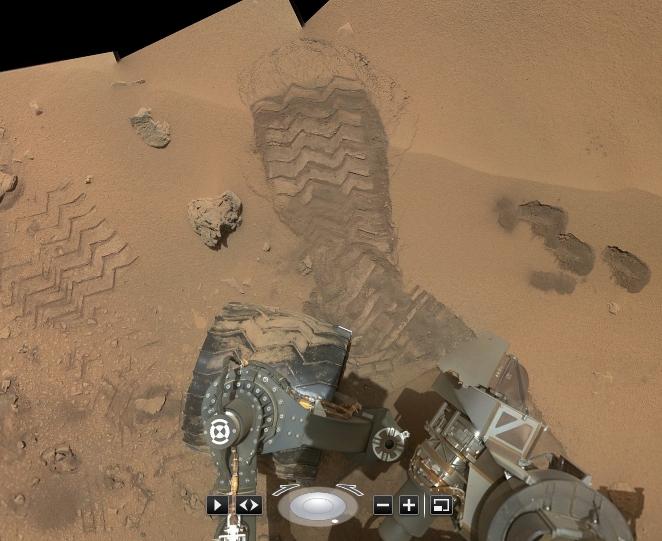
I just want to put this one out there, only because this is ATS and no one has brought up this CT.
Maybe evidence of "life on Mars" is really evidence of Opportunity never leaving the earth. The whole Mars thing is a hoax.
OK Phage, blast away!
Disclaimer: I don't actually believe that Mars exploration is a hoax, I'm just being a smart ass.
Maybe evidence of "life on Mars" is really evidence of Opportunity never leaving the earth. The whole Mars thing is a hoax.
OK Phage, blast away!
Disclaimer: I don't actually believe that Mars exploration is a hoax, I'm just being a smart ass.
It's a shame, nasa has to keep this (must be very tiring) game of hide and no-seek forever. If the truth ever comes out and nasa is found
holding/hiding one the greatest secrets man can ever know bout life elsewhere, they will be the benedict Arnold of the modern day techno world never
to be trusted again, so they must keep the lie going and going and going!!!! a reply to: jeep3r
Brilliant post. Certainly looks like something.
Now, it is interesting when people quote, "it takes so many billions of years for life to form" etc etc.
But, as usual, we are looking from our Earth perspective.
As Phage says, Mars is smaller, and cooled quicker (also further away from Sun).
Mars also takes 1.887 Earth years to orbit the Sun, so a Mars year is twice as long as ours, so when we say 2 billion years ago.....in Mars time that is 4 billion years ago...to our Earth perspective.
So its quite possible that life developed on Mars long long before Earth, Not to mention the Earth is closer to the hotter Sun, so it stayed hotter for longer, And it is fairly well established, that something (Planet, Asteroid) hit Earth in its formative years to create the Moon....delaying progress even further.
I personally think life is everywhere in the Universe, and all basically the same biology.
As the same Primary elements are on Earth, as there seems to be everywhere, including H2O.
Now, it is interesting when people quote, "it takes so many billions of years for life to form" etc etc.
But, as usual, we are looking from our Earth perspective.
As Phage says, Mars is smaller, and cooled quicker (also further away from Sun).
Mars also takes 1.887 Earth years to orbit the Sun, so a Mars year is twice as long as ours, so when we say 2 billion years ago.....in Mars time that is 4 billion years ago...to our Earth perspective.
So its quite possible that life developed on Mars long long before Earth, Not to mention the Earth is closer to the hotter Sun, so it stayed hotter for longer, And it is fairly well established, that something (Planet, Asteroid) hit Earth in its formative years to create the Moon....delaying progress even further.
I personally think life is everywhere in the Universe, and all basically the same biology.
As the same Primary elements are on Earth, as there seems to be everywhere, including H2O.
a reply to: gort51
But from the perspective of the Solar System, it's the same. Time actually flows a bit faster on Mars because of its lower gravity, but not so you'd notice much. How long it takes a planet to circle the Sun doesn't really matter much, unless that early life had a calendar to mark.
Mars also takes 1.887 Earth years to orbit the Sun, so a Mars year is twice as long as ours, so when we say 2 billion years ago.....in Mars time that is 4 billion years ago...to our Earth perspective.
edit on 12/14/2014 by Phage because: (no reason given)
I strongly suspect that NASA scientists are, for many, personally certain that life existed on Mars, and that many believe it still exists
underground. But science and government money does not allow you to report your own beliefs. I think there is enough evidence to support a trip to
investigate in person. I think NASA suggested the same thing a couple weeks ago without saying as much. I hope that trip is not canceled by
politicians.
Some things can point to some kind of growing organism. But crystals grow. With a different chemical makeup and gravity and all the other different
circumstances. All is still speculation. Life is out there some where. Hope we find it soon.
hehe man snake hava & apples www.picshare.ru...
edit on 15/12/14 by mangust69 because: (no reason
given)
a reply to: Phage
Phage, I appreciate how you use facts and reason to bring many of us back down to earth. I was hoping for some of that when I ribbed you. But I'll just have to settle for short and sweat, thanks for the come back.
MSB
Phage, I appreciate how you use facts and reason to bring many of us back down to earth. I was hoping for some of that when I ribbed you. But I'll just have to settle for short and sweat, thanks for the come back.
MSB
edit on 15-12-2014 by MichiganSwampBuck because: Typo
a reply to: this thread
In addition to the OP, I did a few extra comparisons that I think are equally remarkable when considering the terrestial and martian 'similarities'. Note the bosses & dimples on the spherules in the image below:
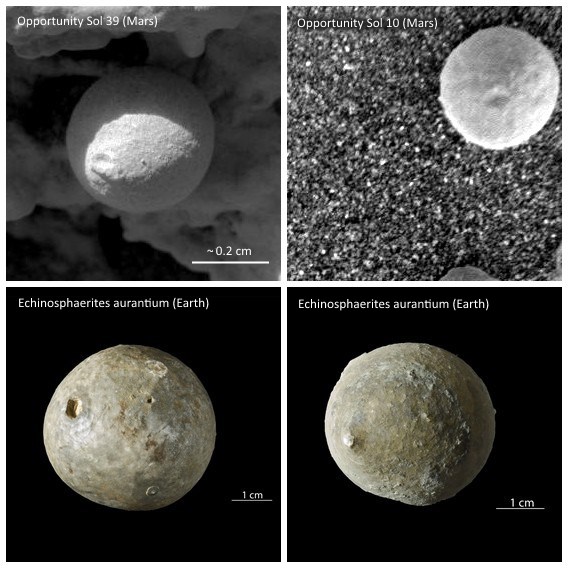 Sources: Opportunity Sol 39 |
Opportunity Sol 10 |
Echinosphaerites
Sources: Opportunity Sol 39 |
Opportunity Sol 10 |
Echinosphaerites
And here goes a pair of images showing both the martian spherules and terrestial cystoid organisms in a similar context (encrusted in rock):
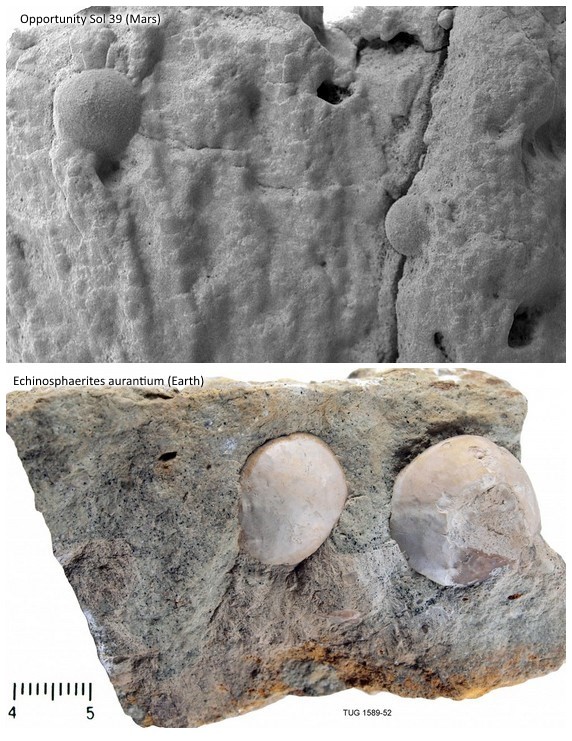 Sources: Opportunity |
Cystoids
Sources: Opportunity |
Cystoids
The first image above has been rotated by 90° in favor of showing a similar orientation. In the background, one can again faintly make out multiple branchings of potential crinoid crown arms.
To me, these early images acquired by Opportunity remain intriguing up to this day - despite the many geological explanations that have been proposed for these features in the past ...
In addition to the OP, I did a few extra comparisons that I think are equally remarkable when considering the terrestial and martian 'similarities'. Note the bosses & dimples on the spherules in the image below:

And here goes a pair of images showing both the martian spherules and terrestial cystoid organisms in a similar context (encrusted in rock):

The first image above has been rotated by 90° in favor of showing a similar orientation. In the background, one can again faintly make out multiple branchings of potential crinoid crown arms.
To me, these early images acquired by Opportunity remain intriguing up to this day - despite the many geological explanations that have been proposed for these features in the past ...
size unclear tooth enamel microscopically www.tooth.by... it ex khazaria: Volgograd youtu.be... Chechnya
youtu.be...
new topics
-
Biden--My Uncle Was Eaten By Cannibals
US Political Madness: 47 minutes ago -
"We're All Hamas" Heard at Columbia University Protests
Social Issues and Civil Unrest: 48 minutes ago -
The good, the Bad and the Ugly!
Diseases and Pandemics: 2 hours ago -
Russian intelligence officer: explosions at defense factories in the USA and Wales may be sabotage
Weaponry: 4 hours ago -
African "Newcomers" Tell NYC They Don't Like the Free Food or Shelter They've Been Given
Social Issues and Civil Unrest: 5 hours ago -
Russia Flooding
Other Current Events: 7 hours ago -
MULTIPLE SKYMASTER MESSAGES GOING OUT
World War Three: 7 hours ago -
Two Serious Crimes Committed by President JOE BIDEN that are Easy to Impeach Him For.
US Political Madness: 8 hours ago -
911 emergency lines are DOWN across multiple states
Breaking Alternative News: 8 hours ago -
Former NYT Reporter Attacks Scientists For Misleading Him Over COVID Lab-Leak Theory
Education and Media: 10 hours ago
top topics
-
Go Woke, Go Broke--Forbes Confirms Disney Has Lost Money On Star Wars
Movies: 15 hours ago, 13 flags -
Pro Hamas protesters at Columbia claim hit with chemical spray
World War Three: 11 hours ago, 11 flags -
Elites disapearing
Political Conspiracies: 13 hours ago, 9 flags -
African "Newcomers" Tell NYC They Don't Like the Free Food or Shelter They've Been Given
Social Issues and Civil Unrest: 5 hours ago, 8 flags -
Freddie Mercury
Paranormal Studies: 16 hours ago, 7 flags -
Two Serious Crimes Committed by President JOE BIDEN that are Easy to Impeach Him For.
US Political Madness: 8 hours ago, 6 flags -
911 emergency lines are DOWN across multiple states
Breaking Alternative News: 8 hours ago, 6 flags -
Biden--My Uncle Was Eaten By Cannibals
US Political Madness: 47 minutes ago, 6 flags -
A Personal Cigar UFO/UAP Video footage I have held onto and will release it here and now.
Aliens and UFOs: 13 hours ago, 5 flags -
Former NYT Reporter Attacks Scientists For Misleading Him Over COVID Lab-Leak Theory
Education and Media: 10 hours ago, 4 flags
active topics
-
"We're All Hamas" Heard at Columbia University Protests
Social Issues and Civil Unrest • 3 • : FlyersFan -
Biden--My Uncle Was Eaten By Cannibals
US Political Madness • 12 • : marg6043 -
911 emergency lines are DOWN across multiple states
Breaking Alternative News • 1 • : xuenchen -
Russian intelligence officer: explosions at defense factories in the USA and Wales may be sabotage
Weaponry • 114 • : FlyersFan -
Marjorie Taylor Greene Files Motion to Vacate Speaker Mike Johnson
US Political Madness • 57 • : Threadbarer -
African "Newcomers" Tell NYC They Don't Like the Free Food or Shelter They've Been Given
Social Issues and Civil Unrest • 10 • : marg6043 -
Joe Biden and Donald Trump are both traitors
2024 Elections • 62 • : Xtrozero -
Nirvana - Immigrant Song
Music • 8 • : PHYSIC2X -
Go Woke, Go Broke--Forbes Confirms Disney Has Lost Money On Star Wars
Movies • 17 • : PHYSIC2X -
A Personal Cigar UFO/UAP Video footage I have held onto and will release it here and now.
Aliens and UFOs • 11 • : PHYSIC2X
